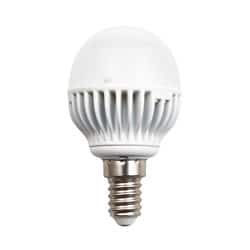Short for “light emitting diode” and introduced commercially in the early 1960’s, the first LEDs produced low levels of red light, and were first used as indicator lights on electronic equipment. As their name suggests, LEDs are diodes, and will operate on both AC and DC electric current. In the mid-seventies, the first digital watches featured LED displays, and in the following decades, LED technology expanded into many applications as LEDs producing most of the light spectrum were developed, from infrared to short wave ultraviolet.
They are more efficient in their consumption of electrical energy than either halogen or fluorescent lighting
Most notable has been the development of LEDs producing extremely bright “white” light. Although these “white LEDs” first produced very cold bluish white light, their output has become more sophisticated, and LEDs are now available which produce “neutral white” as well as “warm white” light. The latter light color is very pleasing, and quite similar in color temperature to light produced by halogen lamps. Another term for LED lighting is “solid state lighting,” as opposed to “hollow state lighting” which describes nearly every other type of lamp or light bulb. LEDs have seven distinct advantages over halogen lamps, and ten advantages over fluorescent lamps. Smaller in size, quicker in response time, and cooler in operation, LEDs last 100,000 hours or more – longer than both halogen and fluorescent lamps. They are more efficient in their consumption of electrical energy than either halogen or fluorescent lighting, and they are safer than other lighting because LEDs can operate on much lower voltages. Also, because they have no delicate glass envelope or fine wire filaments, they are much more resistant to shock and vibration than halogen and fluorescent lamps. Because of their low voltage operation and resistance to impact and vibration, solid state lighting is rapidly replacing all other forms of RV, truck, marine, aerospace, and automotive lighting.
 Very recently, solid state lighting is also appearing in homes and offices. And this is where its additional advantages over fluorescent lamps really shine. First, when operated from a DC power supply, solid state lighting doesn’t flicker like fluorescent lighting, which lends to a much more comfortable environment for individuals sensitive to flickering light. LEDs designed for visible spectrum illumination produce no harmful UV emissions, making them safer for our eyes and for artwork which can fade from exposure to ultraviolet light. Most importantly, LEDs contain none of the hazardous mercury vapor present in all fluorescent lamps, including CFLs (compact fluorescent lamps). Because of the mercury vapor they all contain, fluorescent lamps of all kinds represent a serious and potentially dangerous hazard in our homes, schools, hospitals, public spaces, and offices. They also represent a serious ongoing disaster as we dump literally tons of mercury from discarded fluorescent lamps into our environment every year. So, as prices for LEDs continue to drop, we should all hope to see solid state lighting replace all forms of environmentally hazardous fluorescent lighting. If you are interested in a mercury free home or workspace, please contact Bryant Electric Service for more information, or for a professional bid.
Very recently, solid state lighting is also appearing in homes and offices. And this is where its additional advantages over fluorescent lamps really shine. First, when operated from a DC power supply, solid state lighting doesn’t flicker like fluorescent lighting, which lends to a much more comfortable environment for individuals sensitive to flickering light. LEDs designed for visible spectrum illumination produce no harmful UV emissions, making them safer for our eyes and for artwork which can fade from exposure to ultraviolet light. Most importantly, LEDs contain none of the hazardous mercury vapor present in all fluorescent lamps, including CFLs (compact fluorescent lamps). Because of the mercury vapor they all contain, fluorescent lamps of all kinds represent a serious and potentially dangerous hazard in our homes, schools, hospitals, public spaces, and offices. They also represent a serious ongoing disaster as we dump literally tons of mercury from discarded fluorescent lamps into our environment every year. So, as prices for LEDs continue to drop, we should all hope to see solid state lighting replace all forms of environmentally hazardous fluorescent lighting. If you are interested in a mercury free home or workspace, please contact Bryant Electric Service for more information, or for a professional bid.
